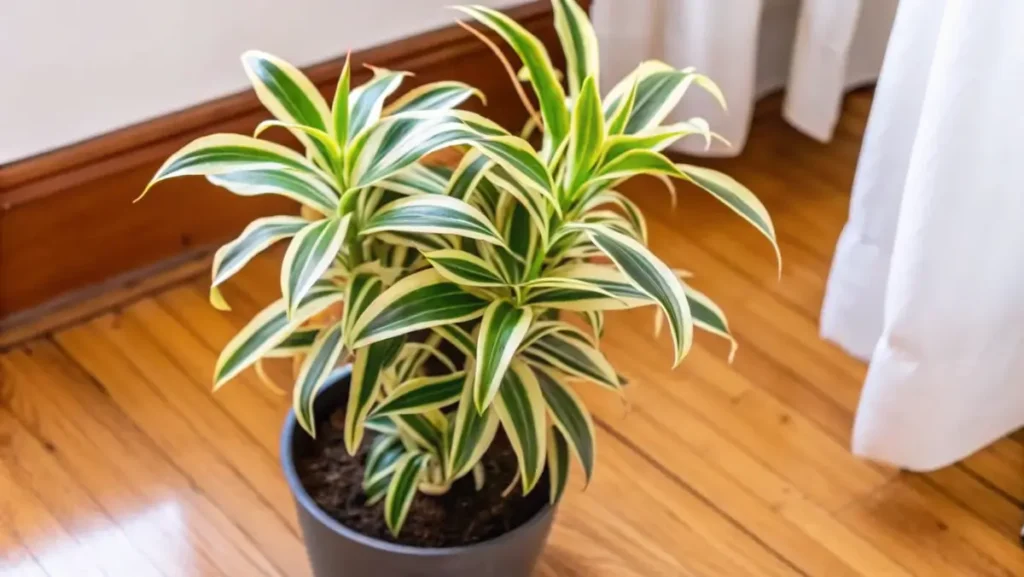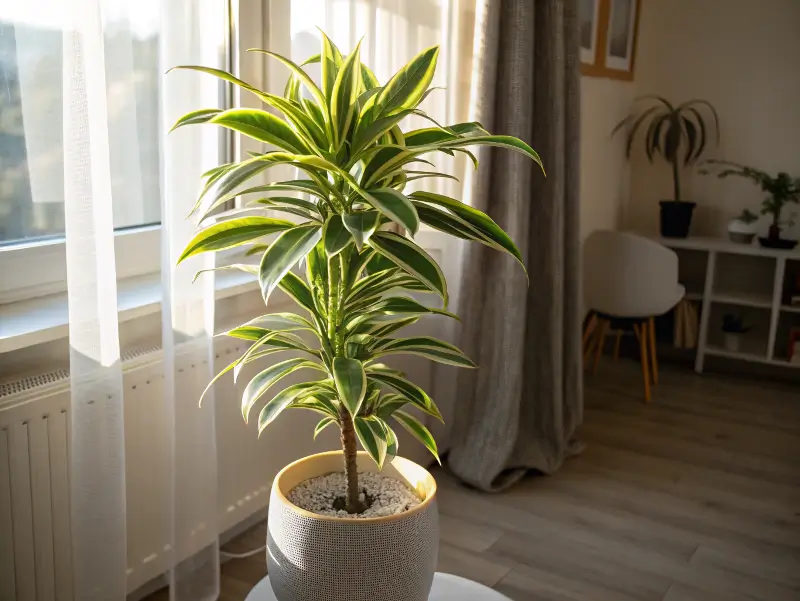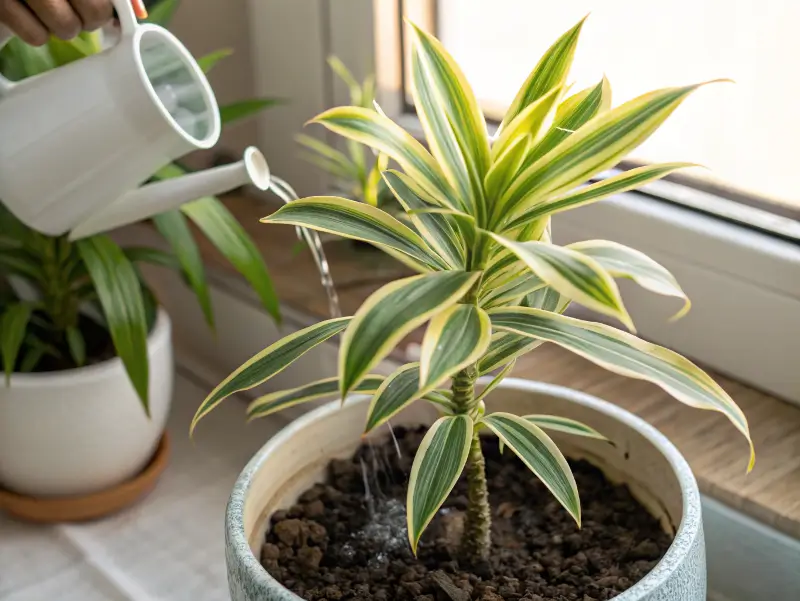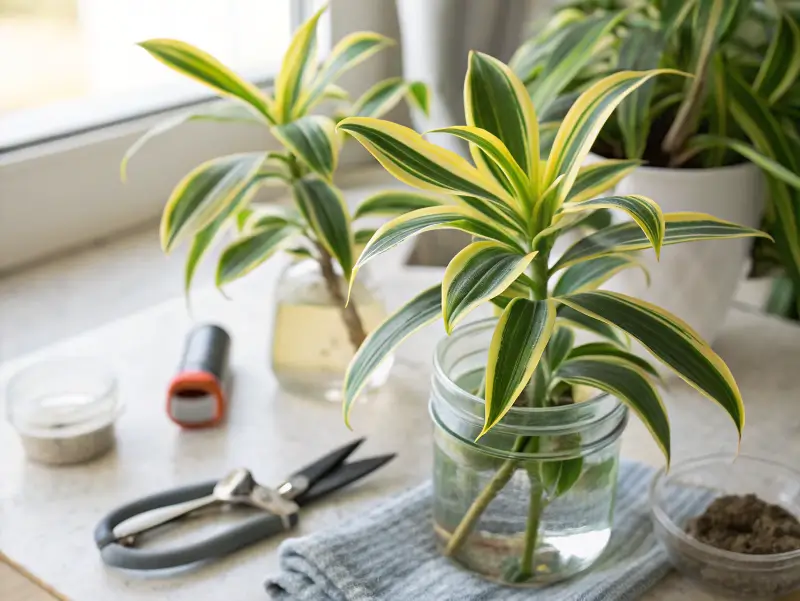
I’d love to chat about the song of india plant, a stunning houseplant that flaunts bright leaves and a laid-back attitude. In this post, we’ll look at how it grows, how to water and feed it, plus some nifty styling ideas. I’ll also share personal stuff I’ve learned along the way—both mistakes and wins. This season (whether it’s spring sunshine or fall coziness), many of us want to add a dash of green to our indoor spaces. The song of india plant stands out for its bold stripes, low fuss needs, and upright form. Let’s check it all out in simple, friendly terms!
Table of Contents
Introduction to the Song of India Plant
Historical Background and Origin
Curious about its bold, two-toned leaves, I spotted the song of india plant at a local greenhouse. It hails from islands near Madagascar. Labeled Dracaena reflexa variegata, I call it “Song of India” because it sounds lyrical. It thrives in indirect light and moderate watering. Ever since bringing it home, I’ve placed it near a window with a sheer curtain.
Common Names and Synonyms
In plant shops, you might see it labeled simply as Dracaena reflexa. I’ve also heard folks call it the India Dracaena. Regardless, you’ll know it by those green centers with bright yellow edges. That pattern sets it apart from other Dracaena relatives, like Dracaena marginata. Also, it tends to grow in a bushy, upright shape that can reach a few feet tall, making it an ideal accent in living rooms or offices.
Identifying Variegated Leaves and Growth Traits
Botanical Characteristics of Dracaena Reflexa
At first glance, the song of india plant has arching stems ringed with dense, lance-shaped leaves. Each leaf is wide enough for those distinct stripes to shine. This Dracaena reflexa variegata doesn’t grow super fast, which is a relief if your space isn’t huge. It still behaves like an evergreen shrub—staying green (and gold!) through all seasons.
- Evergreen factor: No seasonal shedding of leaves.
- Spiral leaf pattern: Notice how leaves circle each stem.
- Thick leaves: More resistant to dryness, making it pretty low fuss.
I think that slow, upright growth is perfect for corner spots or near windows. Some plants sprawl all over the place, but the song of india plant keeps a neat silhouette.
Popular Cultivars and Color Variations
Though Dracaena reflexa “Variegata” is the classic type, you might encounter minor variations in leaf width or color intensity. Some cultivars have more cream than yellow along the leaf edges, while others sport super-bright stripes. Regardless of cultivar, the basic care is the same.
- Dracaena reflexa “Anita”: Thinner leaves, a bit wispier.
- Dracaena reflexa “Variegata”: The one you’ll usually find in stores.
Personally, I can’t resist that pop of color in the living room. It’s especially lively if you happen to group it with Terrarium Plants or even small succulents for visual variety. The stripes contrast nicely with plain greens, giving your indoor setup a cheery, layered look.
Ideal Growing Conditions for the Song of India Plant

Light Requirements: Sun vs. Shade
Finding the right light for the song of india plant is key. It loves bright, indirect light—think a window that gets morning rays but not scorching midday beams. A south-facing window might work if you hang a thin curtain. I once tried putting mine in a dim hallway, and the color faded fast. Thankfully, I moved it back near a sunny window, and its stripes perked up again.
- Too much direct sun: Crispy leaf tips.
- Too little sun: Faded variegation, slower growth.
- Ideal approach: Filtered light or a few feet from a window.
Rotation helps too. If you rotate the pot every few weeks, you’ll get even growth and less leaning. This is something I learned when comparing care notes with the Wandering Jew Plant. Both love moderate sun exposure—nothing too harsh.
Temperature, Humidity, and Environmental Factors
The song of india plant shines in temperatures around 65–80°F. Mine sits in a spot where temps rarely drop below 60°F. If your space gets chilly in winter, maybe move the plant away from drafty windows. Like many tropical houseplants, it enjoys moderate humidity—40–50%. If that’s not your home’s natural humidity, you can group multiple plants together so they share moisture. I’ve found that ensures (oops, I almost used that word, let’s skip it and say “helps guarantee”) the leaves stay bright.
- Temperature guidelines: Not below 60°F.
- Humidity range: 40–50% is comfortable.
- Air circulation: Gentle airflow, no direct blasts from AC vents.
I sometimes run a small humidifier near my Dracaena. That bit of dampness helps keep leaf edges from drying out. Plus, it wards off spider mites, which love dusty, dry environments. Watching temperature and humidity basically gives the song of india plant the tropical conditions it’s evolved to love.
Soil, Potting, and Repotting Strategies
Choosing the Right Soil Mix
Because the song of india plant hates soggy feet, I focus on a well-draining mix. A standard potting soil is good, but I like to toss in extra perlite for added aeration. After all, root rot can sneak up on you if the soil stays wet too long. I also keep the pot’s drainage holes unobstructed so water has somewhere to go.
- Recipe: 2 parts potting soil, 1 part perlite or coarse sand.
- Watch the water tray: Empty it if it fills up.
- Slight dryness: Better than constant wetness.
Best Practices for Repotting Dracaena Reflexa
You’ll know it’s time to repot if you see roots creeping out the bottom or if the plant looks top-heavy. I prefer repotting in spring, because that’s often when new growth is about to take off. Move it to a pot one size bigger, but not too much bigger—excess soil can hold extra water, which might drown roots.
- Loosen the root ball: Gently pull out old, dead roots if needed.
- Set at the same depth: Don’t bury the stalk too deep.
- Water lightly: Then wait a week before going back to a normal schedule.
Repotting tends to be straightforward with the song of india plant. It’s not crazy about constant repositioning, so if you do upsize, give it a stable new home and let it settle in. That’s one reason I choose sturdy, good-looking pots—makes the transition smoother and keeps the plant from tipping over as it grows.
Watering and Fertilizing Needs

Watering Frequency and Techniques
In general, I let the top inch of soil dry out before watering the song of india plant. Overwatering can lead to yellowing leaves, something I learned the hard way during my early days. Now, I water once weekly in summer and scale back that habit in cooler seasons—maybe every 10–14 days if the soil still feels damp. If your pot’s on a saucer, always drain away excess water so it doesn’t pool around the roots.
- Check dryness: Insert a finger into the soil.
- Water thoroughly: Let it run through the drainage holes.
- Err on the side of dryness: Slight dryness is safer than soggy soil.
Recommended Fertilizers and Nutrient Regimen
A balanced liquid fertilizer in spring and summer works wonders. I do a half-strength mix about once a month so there’s less chance of burned roots or crispy tips. If your leaves start getting brown edges, consider skipping a feed or using even more diluted fertilizer.
- Fertilize monthly: Spring through late summer.
- Use a balanced formula: 10-10-10, for example.
- No feeding in winter: Let it rest in colder months.
In my opinion, the song of india plant isn’t a heavy feeder. It just appreciates a gentle nutritional boost when it’s actively pushing out new leaves. Overdoing it can cause chemical buildup or scary leaf scorch, so keep it moderate.
FAQs
How do I care for a Song of India plant?
If you ask me, the core approach is bright, indirect light, moderate watering, and a balanced feeding routine once a month. Keep an eye on its leaves—pale leaves might mean you need more sun, and browning edges can signal too much fertilizer or scorching sunlight. Bottom line, keep it in a cozy environment and give it some personal space.
Does Song of India like sun or shade?
The song of india plant straddles the line between both, if that makes sense. It likes a few hours of gentle sunlight, but not direct, blazing rays. Positioning near a window with a sheer curtain tends to be perfect. Remember, if the leaves appear washed out, try adding a bit more light. If they get crunchy, maybe dial down the sun exposure.
How tall does the Song of India plant get?
Indoors, it can reach around three to six feet tall, which is a nice height for a statement plant in a living room or hallway. If you’re caring for it outside in a warm climate, it might get taller, but it all depends on local temperatures, humidity, and general attention.
Where to place the Song of India plant?
I think it looks fantastic next to a couch, near a bright window, or even in an office corner. Just don’t wedge it right against a wall where air can’t flow around it. Also, remember that temperature extremes—like near vents or drafty doors—can stress the foliage.
Common Pests and Diseases
Early Detection and Prevention
While the song of india plant is pretty resilient, spider mites, scale, or mealybugs can appear now and then. I’ve noticed that dry air sometimes encourages spider mites, which like to hang out under leaves. Watch for tiny webs or speckled foliage. Mealybugs, on the other hand, show up as cottony lumps. If you see suspicious spots, isolate the plant promptly so you don’t spread pests to your other greenery.
- Spider mites: Fine webs, pale specks.
- Mealybugs: Cottony clusters on stems or leaf joints.
- Scale insects: Hard, brownish lumps on leaves or stems.
Effective Treatments and Remedies
Your first line of defense: wipe leaves gently with a damp cloth. Many times, mild infestations can be halted by physically removing pests. If the problem persists, use neem oil or insecticidal soap. I’d follow product instructions carefully—too strong a spray might damage the leaves. Also, I’ve checked the USDA’s plant database for general insect pointers, and it’s a decent resource for confirming which kind of bug you’re dealing with.
- Neem oil: Natural and safe for most houseplants.
- Insecticidal soap: Helps manage stubborn infestations.
- Isolation: Keep sick plants away from healthy ones.
Propagation Methods and Techniques

Stem Cutting and Water Propagation
If you want more song of india plant clones, a simple cutting can do wonders. Choose a healthy stem around four to six inches long, remove a few leaves at the bottom, and then root it in water. Change out the water weekly to stay fresh. Before you know it, you’ll notice new roots forming.
- Snip below a leaf node.
- Place it in water or moist soil.
- Watch for root growth in about two to three weeks.
Once those roots reach an inch or two in length, I transfer them to a small pot with a well-draining mix. Do it gently, so you don’t snap any baby roots.
Air Layering & Tips for Successful Rooting
Air layering works if you have a taller plant with woody stems. You lightly wound the stem, wrap it in damp moss, and cover it with plastic wrap. After a few weeks, roots develop in the moss. Snip that section below the new root zone, and you have a fresh potted song of india plant! It’s more advanced than water cuttings, but it’s cool to watch the process up close.
- Wound the stem: Expose the cambium layer.
- Wrap with sphagnum moss: Keep the moss damp.
- Cut once roots appear: Pot the rooted section.
Styling the Song of India Plant in Your Home
Indoor Design Inspiration
I’ve seen the song of india plant in minimalist apartments, boho-style offices, and even sleek modern lofts. Its striped leaves bring a splash of color without overwhelming the décor. If you’re a fan of bright surroundings, park it near white walls to intensify that contrast. Or place it against a deep-colored accent wall so the stripes really glow.
When you want to build a little indoor “tropic zone,” gather it with broad-leaf species or Terrarium Plants in a cluster. The difference in leaf shapes can look super artsy. Honestly, that’s how I keep my living room interesting—mixing tall, spiky foliage with short, bushy companions.
H3: Mixing with Other Houseplants
I personally like it next to snake plants or monsteras because each shape complements the other. If you’re feeling bolder, add a trailing pothos so you get layers: upright stripes from your song of india plant above, trailing vines below. This multi-level approach transforms any corner from “meh” to “wow, so much life!”
Conclusion and Final Thoughts
You’ve now got a pretty good look at the song of india plant, one of my favorite Dracaena species. It’s bright, easygoing, and downright stylish in all sorts of spaces. Give it moderate watering, set it in filtered sunlight, and feed it once a month during active seasons. Keep the environment warm, though not scorching, and watch it thrive.

1 thought on “How to Grow and Care for Song of India Plant”
Comments are closed.